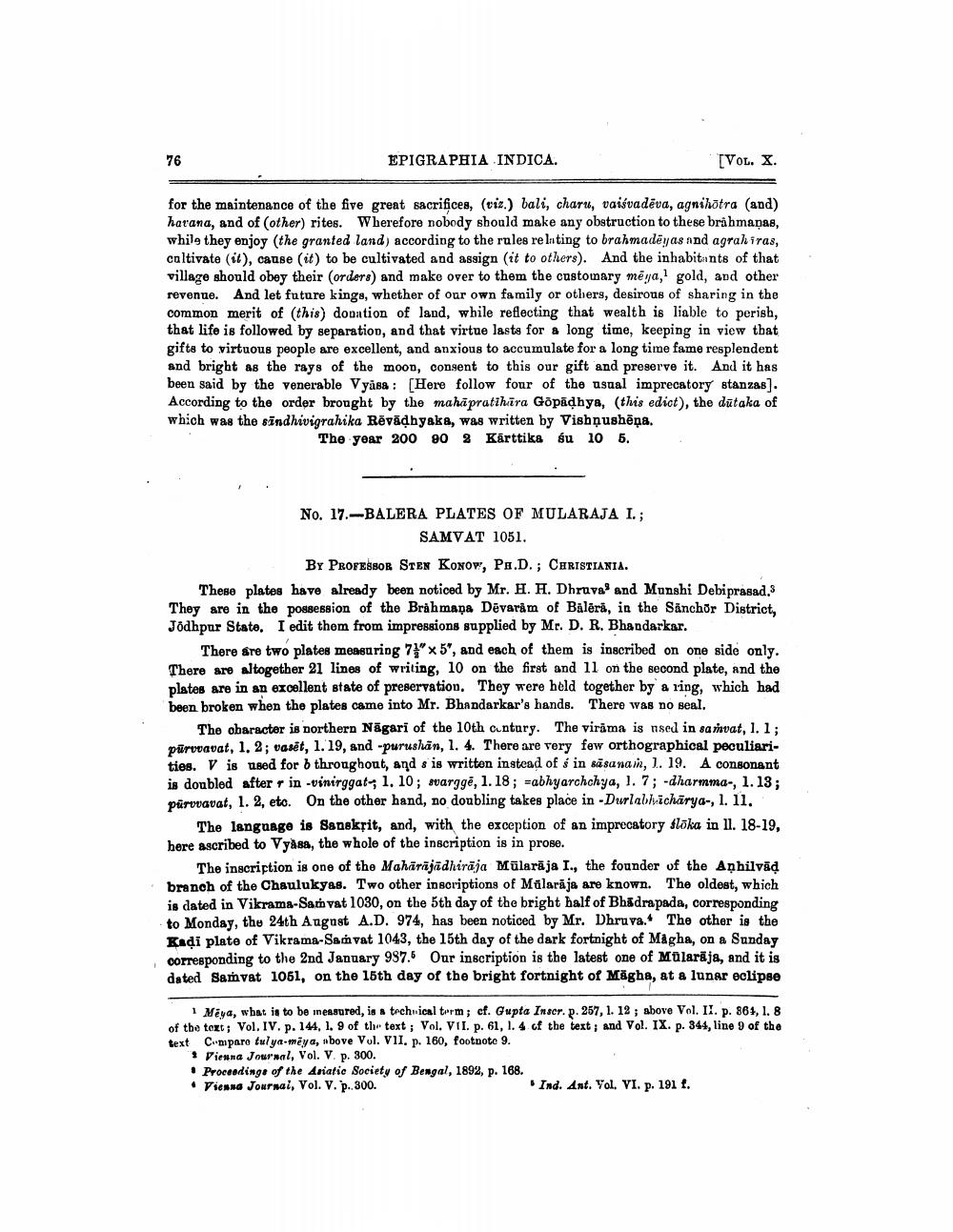________________
EPIGRAPHIA INDICA.
[Vol. X.
for the maintenance of the five great sacrifices, (viz.) bali, charu, vaisvadēva, agnihotra (and) harana, and of (other) rites. Wherefore nobody should make any obstruction to these brahmaņas, while they enjoy the granted land) according to the rules relating to brahmadēyas and agrahiras, coltivate (it), cause (it) to be cultivated and assign (it to others). And the inhabitants of that village should obey their orders) and make over to them the customary męya, gold, and other revenue. And let future kings, whether of our own family or others, desirous of sharing in the common merit of (this) dodation of land, while reflecting that wealth is liable to perish, that life is followed by separation, and that virtue lasts for a long time, keeping in view that gifts to virtuous people are excellent, and anxious to accumulate for a long time fame resplendent and bright as the rays of the moon, consent to this our gift and preserve it. And it has been said by the venerable Vysa : [Here follow four of the usual imprecatory stanza8]. According to the order brought by the mahā pratihīra Gopadhya, (this edict), the dūtaka of which was the sindhivigrahika Rēvādhyaka, was written by Visbņushēņa.
The year 200 80 % Kārttikasu 10 5.
No. 17.-BALERA PLATES OF MULARAJA I.;
SAMVAT 1051. BY PROFESSOR STEN KONOP, PA.D.; CHRISTIANIA. These plates have already been noticed by Mr. H. H. Dhruval and Munshi Debi prasad S They are in the possession of the Brahmana Dēvarm of Balēra, in the Sanchor District. Jodhpur State. I edit them from impressions supplied by Mr. D. R. Bhandarkar.
There are two plates measuring 7}" x 5", and each of them is inscribed on one side only. There are altogether 21 lines of writing, 10 on the first and ll on the second plate, and the plates are in an excellent state of preservation. They were held together by a ring, which had been broken when the plates came into Mr. Bhandarkar's hands. There was no seal.
The character is Dorthern Nāgari of the 10th cuntury. The virāma is nsed in samvat, 1. 1; pūrvuavat, 1. 2; vaset, 1. 19, and -purushān, 1. 4. There are very few orthographical peculiarities. V is used for throughout, and s is written instead of sin sāsana, 1. 19. A consonant is donbled after r in-vinirggat, 1. 10; svarggé, 1.18; -abhyarchchya, 1. 7; -dharmma-, 1. 13; pūrvuavat, 1.2, eto. On the other hand, no doubling takes place in - Durlablacharya-, 1. 11.
The language is Sanskřit, and, with the exception of an imprecatory slāka in ll. 18-19, here ascribed to Vyåsa, the whole of the inscription is in prose.
The inscription is one of the Mahārājādhiraja Mūlarä ja I., the founder of the Anbilvād branch of the Chaulukyas. Two other inscriptions of Mälarāja are known. The oldest, which is dated in Vikrama-Sam vat 1030, on the 5th day of the bright half of Bhadrapada, corresponding to Monday, the 24th August A.D. 974, has been noticed by Mr. Dhruva.. The other is the Kadi plate of Vikrama-Samvat 1043, the 15th day of the dark fortnight of Magha, on a Sunday corresponding to the 2nd January 987.6 Our inscription is the latest one of Mülarāja, and it is dated Samvat 1061, on the 15th day of the bright fortnight of Mägha, at a lunar eclipse
Meya, what is to be measured, in a trchnical term; cf. Gupta Inscr. p. 267, 1. 12 ; above Vol. II. p. 861, 1. 8 of the text, Vol. IV. p. 144, 1. 9 of the text ; Vol. VII. p. 61, 1. 4 of the text; and Vol. IX. p. 344, line 9 of the text Compare tulya-mēya, above Vol. VII. p. 160, footnote 9.
Vienna Journal, Vol. V. p. 300. • Proceedings of the Asiatic Society of Bengal, 1892, p. 168. • Vienna Journai, Vol. V. p. 300.
Ind. Ant. Vol. VI. p. 191 t.




